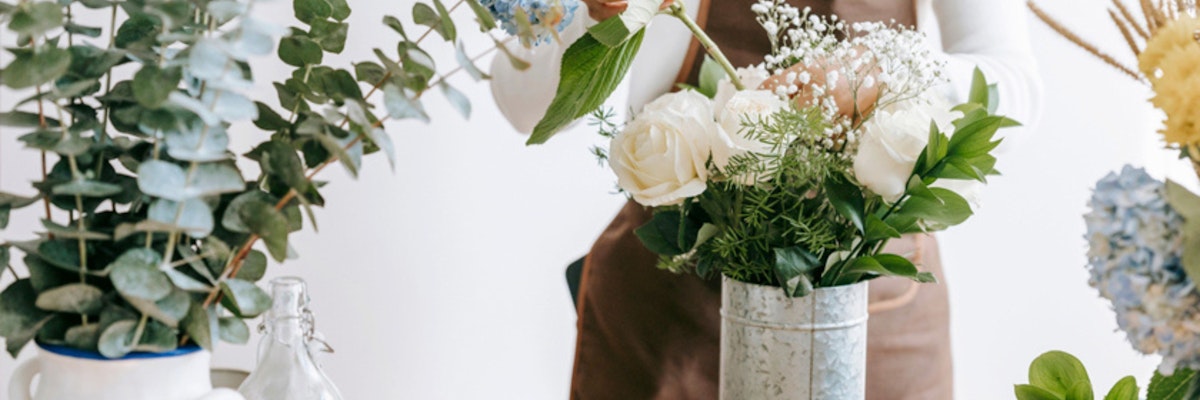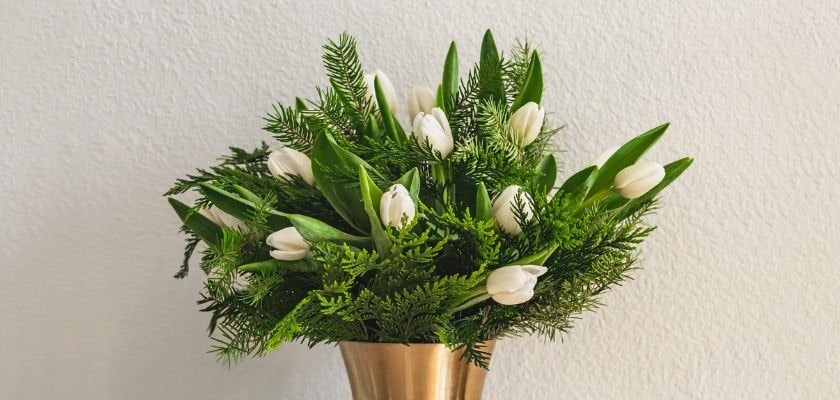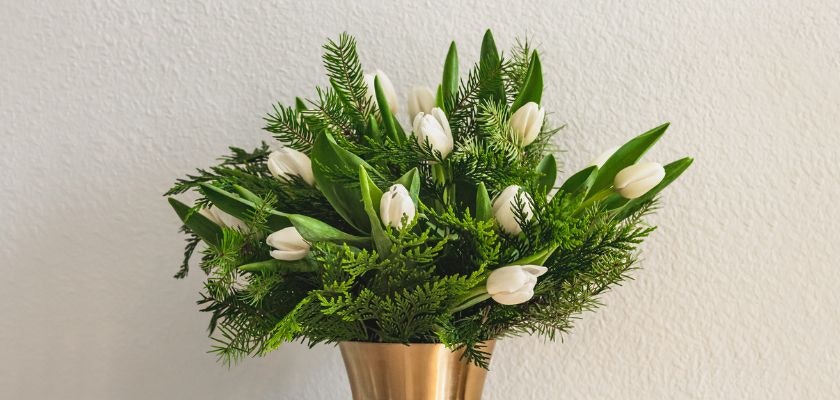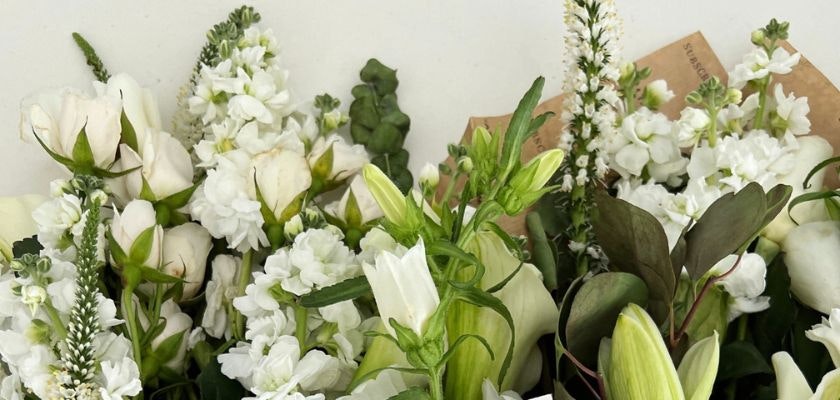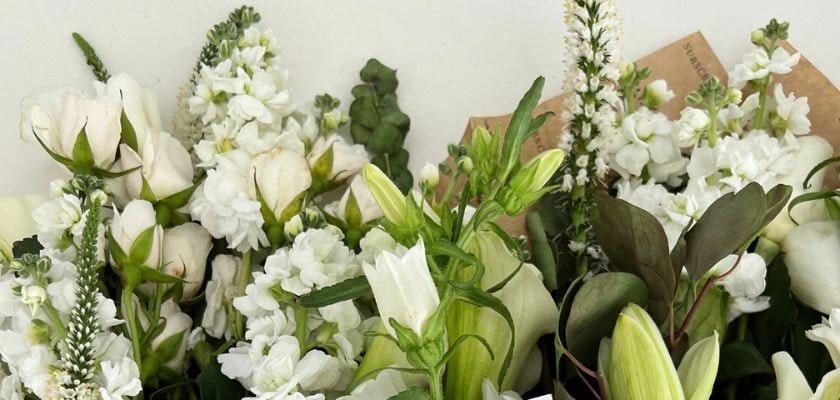Funeral Flower Etiquette: Everything You Should Know
Funerals are somber occasions where emotions run deep, and the smallest gestures of kindness carry significant weight. Among these gestures, sending flowers remains one of the most timeless and heartfelt ways to express sympathy, support, and respect for the grieving family.
Funeral Flower Etiquette | Understanding Condolence Traditions
Funeral flowers serve as a visual tribute to the deceased while offering comfort to those mourning their loss. However, understanding the appropriate etiquette for funerals when sending flowers is essential for ensuring your gesture is both meaningful and respectful.
Flowers have long been a part of condolence traditions across cultures and regions. Their beauty and symbolism provide solace during challenging times, conveying messages of love, remembrance, and eternal peace. Yet, each type of flower, color, and arrangement carries its unique significance in this context, which makes choosing the right bouquet an emotionally delicate task. A thoughtful selection reflects not only your regard for the deceased but also your awareness of the grieving family’s values and beliefs.
Knowing the differences in funeral flower arrangements is another important aspect. From wreaths and sprays to casket covers, each arrangement serves a specific purpose and location within the memorial service. Understanding these nuances helps you pick something that aligns with the tradition and ceremony while avoiding unnecessary faux pas. Additionally, knowing when and where to send flowers ensures your tribute is received at the most appropriate time.
Cultural and religious customs also play a role in the selection process. What may be considered a thoughtful gesture in one tradition could potentially be viewed as inappropriate in another. Being attuned to these details helps you convey your sympathy with care and thoughtfulness.
This guide on funeral flower etiquette dives into all these aspects, offering practical advice to help you make informed and respectful decisions. From popular flower choices for sympathy gifts to the subtle art of selecting arrangements that suit the occasion and family preferences, this article aims to simplify what can often feel like an overwhelming process.
By following the dos and don’ts outlined here, you can ensure your gesture of sending flowers brings a sense of comfort and peace to those mourning their loss, while also honoring the deceased in a meaningful way. With insights into arrangements, color symbolism, delivery etiquette, and more, this guide will prepare you to send funeral flowers with care and respect.
The Significance of Funeral Flowers
Funeral flowers hold immense significance. They are more than just arrangements of petals and stems; these blooms carry emotions and messages that words often cannot express. The choice of flowers serves as a comforting presence, a symbol of love, and a tribute to a life well-lived. The tradition of expressing condolences through flowers dates back centuries, evolving over time to represent both universal and personal sentiments.
Each flower type symbolizes something unique, making it possible to tailor your arrangement to the attributes of the deceased or the specific sentiment you wish to convey. For example, lilies are popularly associated with purity and the soul’s rebirth, making them a common choice for funerals. Similarly, white roses symbolize peace and reverence, while chrysanthemums represent mourning and grief in many cultures. By understanding these symbolic meanings, you can craft a deeply personalized tribute.
Funeral flowers play a functional role in easing the atmosphere of a service. Their natural beauty softens the setting, adding warmth to an otherwise solemn occasion. Arrangements such as standing sprays or wreaths are prominently displayed near the casket or altar, offering visual comfort to families and visitors. These blooms enhance the memorial environment, ensuring that grief is met with beauty and tranquility.
They also create a sense of shared support and community. When attendees see a room filled with thoughtful floral tributes, it conveys a collective outpouring of love and care for the grieving family. This subtle yet powerful message can be incredibly uplifting, reminding those in mourning that they are not alone during their time of loss.
Cultural and religious significance also plays a role in the importance of funeral flowers. For example, in Christian funerals, lilies are celebrated for their connection to the Virgin Mary and resurrection, while in Buddhist traditions, white flowers like chrysanthemums are considered symbols of grief and purity. Understanding these connections helps make your gesture more meaningful and appropriate.
Additionally, funeral flowers can be seen as living symbols of remembrance. Over time, as flowers fade, they poignantly remind attendees of the fleeting nature of life and the beauty of cherishing memories. They signal a shift from mourning a loss to celebrating a life, helping families find comfort in their loved one’s legacy.
Services like BloomsyBox simplify the process of selecting meaningful funeral flower arrangements by offering curated options designed for sympathy and condolence. Every detail, from flower type to presentation, reflects thoughtful consideration, making it easier for you to honor the deceased and support the grieving family during a difficult time.
Flowers also serve as gentle enablers of communication for those who struggle to articulate their emotions in words. Whether your bouquet conveys sympathy, support, or reverence, it ensures that important sentiments are still shared during a time when they matter most.
Types of Funeral Flower Arrangements
When selecting funeral flowers, understanding the variety of arrangements available and their intended purposes is crucial. Each type carries symbolic and functional significance, ensuring your choice contributes meaningfully to the ceremony. One common arrangement is the standing spray. These floral displays are often placed on easels and positioned near the casket. Their upright design symbolizes peace and hope, making them an enduring choice for many funerals. Standing sprays are often bold and dramatic, drawing the eye and offering a focal point for reflection.
Casket sprays, on the other hand, are specifically designed to rest atop the casket itself. These arrangements are generally provided by the immediate family of the deceased and represent their deep connection and final farewell. They are often composed of a harmonious mix of white flowers such as lilies, roses, and carnations, with complementary greenery that softens the design.
Another popular arrangement is the funeral wreath. These circular displays symbolize eternity and the perpetual cycle of life and death. Crafted with flowers like chrysanthemums, roses, and carnations, wreaths are versatile and can be displayed at the funeral home, the church, or by the gravesite. Their circular form conveys a unifying and timeless message, making them a widely appreciated option.
Bouquets and baskets, though simpler, are profoundly moving. Sympathy baskets can be sent directly to the family as a token of condolence, often accompanied by a heartfelt note. These arrangements are particularly suited for ensuring that families feel your support in the days following the service. Meanwhile, hand-tied bouquets are personal and intimate gestures, serving as portable, meaningful tributes that the family can later take home.
For those seeking something more unique, floral hearts and crosses offer deeply personal options. Floral hearts represent enduring love and compassion, while crosses signify faith and hope, aligning with Christian traditions. These designs are often displayed near the casket or as part of the memorial setup, making a strong yet tender statement about the deceased’s values or beliefs.
BloomsyBox offers a range of options to suit different needs and circumstances. Their curated sympathy gifts include beautifully crafted arrangements that cater to various traditions and preferences. Whether you choose a standing spray or a quieter bouquet, their emphasis on quality ensures that your gesture conveys care and thoughtfulness.
Knowing the appropriate arrangement to send for the situation is essential to funeral etiquette. For instance, family members might opt for formal casket sprays, while extended relatives and friends might consider standing sprays, wreaths, or sympathy baskets. By choosing an arrangement that aligns with your role and the family’s expectations, you can ensure your flowers are appreciated and understood in the spirit they are given.
Each type of arrangement serves as a vessel for emotion, carrying messages of love, hope, and remembrance. The selections you make, down to the flowers and their placement, reflect not just your respect for the deceased but also your sensitivity to the mourning family’s needs and cultural expectations.
The Cultural and Religious Influence on Funeral Flowers
Funeral customs vary widely across cultures and religions, influencing not only the types of flowers used but also how they’re arranged and displayed. Awareness of these nuances is an essential part of etiquette for funerals and ensures that your gesture of sympathy aligns with the family’s traditions and values.
For instance, in Western Christian traditions, white lilies are often favored for their association with purity and resurrection. These flowers carry strong religious connotations, embodying the soul’s rebirth and peace. Other suitable choices include white roses and chrysanthemums, which also symbolize reverence and memory, fitting seamlessly with Christian ceremonies.
By contrast, in Buddhist traditions, simplicity is key. White flowers, particularly chrysanthemums, are preferred for their symbolism of grief and mourning. These blooms are often presented in restrained, minimalist arrangements that reflect the Buddhist values of humility and impermanence. Western-style bouquets filled with varied colors may be considered inappropriate in these settings, as they might contrast with the somber tone of the occasion.
Hindu funerals emphasize simplicity and rely largely on garlands and loose flower petals. Marigolds are particularly significant in Hindu mourning rituals, symbolizing purity and their belief in the cyclical nature of life and death. Floral offerings are predominantly yellow and white, arranged in patterns that honor the deceased’s transition to the afterlife.
For Jewish funerals, flowers are not traditionally part of the customs. Instead, condolence traditions often involve sending food or charitable donations in memory of the deceased. However, some families may accept or appreciate flowers depending on their modern or reform practices. When in doubt, it’s best to consult with someone close to the family before sending floral condolences.
Islamic funerals may also vary when it comes to flower etiquette. While offering sympathy gifts in other forms, like food or money, is more customary, flowers might still be considered appropriate, depending on the family’s preferences. If selected, white flowers are often the safest option, symbolizing peace and simplicity.
Understanding these cultural and religious influences can make your gesture more meaningful and considerate. When selecting funeral flowers, you acknowledge not only the grieving family but the traditions that shape their mourning process. Services like BloomsyBox simplify this process by offering thoughtfully designed options that cater to diverse preferences and practices. By leveraging such resources, you can ensure your flowers convey the right sentiment while respecting cultural boundaries.
The key to navigating cultural nuances lies in thoughtfulness and sensitivity. By taking the time to research or ask questions, you demonstrate genuine care for the family’s values, ensuring your flowers are received as a gesture of love and respect, rather than one of misunderstanding or oversight.
Color Symbolism in Funeral Flowers
The color of flowers plays a significant role in conveying sentiments during a funeral. Understanding the meanings associated with different colors can help you select arrangements that appropriately honor the deceased while offering comfort to the grieving family. White, unsurprisingly, is the most traditional color for funeral flowers. It symbolizes purity, peace, and eternal rest, making it a fitting choice for expressing respect and reverence. White flowers often dominate casket sprays, wreaths, and standing sprays, projecting a sense of calm during a difficult time.
Red flowers, on the other hand, carry powerful emotions. They signify love, respect, and passion, often reserved for close family members or deeply loved individuals. Red roses in particular create stunning and heartfelt arrangements that speak volumes without the need for words. Paired with greenery or white blooms, they strike a balance between beauty and emotion.
Pink flowers are associated with gentle admiration and love, making them ideal for expressing subtle emotional connections. They are often chosen for families who wish to celebrate the deceased’s kindness and loving nature. Pink lilies, carnations, or roses create soft and beautiful arrangements that contribute to a warm memorial setting.
Yellow flowers, while less common, symbolize friendship and a celebration of life. They add a touch of brightness to funeral arrangements, reminding attendees of happier memories with the deceased. Flowers like yellow roses or daisies can enhance a memorial gathering, paying tribute to a life that brought joy to others.
Purple flowers carry connotations of dignity, royalty, and respect. Their rich hues add depth to arrangements, making them a sophisticated option for funerals. Purple blooms, such as irises or hydrangeas, work beautifully in combination with softer pastels, creating a layered floral tribute.
For a more dramatic and unique option, red and black flowers are sometimes used in funeral ceremonies. Black flowers, often represented by dark purple calla lilies or deep burgundy roses, signify mourning and farewell. These are typically reserved for modern or personalized funeral themes and often appeal to families seeking a non-traditional yet meaningful expression of grief.
Using mixed colors in flower arrangements is another thoughtful way to convey multiple sentiments. Combining white, red, and pink blooms creates a harmonious blend of respect, love, and admiration. These arrangements often stand out as elegant and thoughtful tributes that honor the complexity of the deceased’s life and relationships.
Online platforms like BloomsyBox simplify the process of selecting flowers with symbolic colors by offering detailed descriptions and suggestions for each arrangement. Their curated designs ensure that every choice reflects the rightful sentiments, helping you extend your condolences in a sincere and visually impactful way.
Color symbolism in funeral arrangements adds a deeper layer of meaning to your gift. By carefully selecting the shades and tones that resonate with your message, you can create a floral tribute that embodies both your emotions and your respect for the grieving family. This thoughtfulness ensures that your gesture is not just seen but felt by those mourning their loss.
The Dos and Don’ts of Selecting Funeral Flowers
Choosing the right funeral flowers requires sensitivity and care to ensure your gesture is appropriate and comforting for the grieving family. Knowing the dos and don’ts helps you avoid unintended missteps while making your floral tribute meaningful and impactful.
One of the key dos is researching the traditions and preferences of the family or deceased. For example, while white flowers are universally accepted, some cultures or religions may have specific color or arrangement preferences. Taking the time to learn about their beliefs reflects care and respect for their mourning customs, ensuring your gesture aligns with their values.
Always include a note or card with your arrangement. A heartfelt message adds a personal touch, transforming your flowers into a meaningful tribute that conveys your emotions and condolences. Keep it simple and sincere, focusing on your support and sympathy for the family. For instance, phrases like “Thinking of you in this difficult time” or “Wishing you peace and comfort” are thoughtful ways to express your sentiments.
Consider the relationship you share with the deceased or the family when choosing your arrangement. Close friends and relatives often select larger displays, such as standing sprays or casket covers, while more distant acquaintances may opt for smaller options like hand-tied bouquets or sympathy baskets. This reflects thoughtfulness in both scale and sentiment.
On the flip side, avoid overly bright and casual arrangements unless they are explicitly fitting for the family’s preferences or ceremony. Bright and eclectic designs that might suit a birthday or joyous occasion could feel out of place in the solemn context of a funeral. Similarly, avoid including balloons, glitter, or overly whimsical elements, as they can seem insensitive in this setting.
Timing is another important factor in funeral flower etiquette. Do send your arrangement promptly, ideally before or on the day of the funeral service. This ensures that your sympathy gift creates the intended support and tribute at the right moment. If you’re delayed, consider sending your flowers to the family’s home instead, accompanied by a thoughtful note.
Another don’t is disregarding allergies or sensitivities. Some people, including the immediate family, might have allergies or sensitivities to strong floral scents. Opt for less fragrant flowers when unsure, or include greenery to balance and soften the arrangement while still creating a visually appealing display.
BloomsyBox simplifies this process with flower selections curated specifically for funerals and sympathy. Their approachable platform ensures you choose the right arrangement while offering delivery options that fit the family’s needs. You can rely on their commitment to quality and thoughtful designs, making the process both seamless and meaningful.
By adhering to these dos and don’ts, you can create a tribute that speaks volumes without causing discomfort or misunderstanding. Following these guidelines demonstrates care for the grieving family while providing a visual and emotional source of support during their time of loss.
The Role of Sympathy Gifts Beyond Flowers
While funeral flowers are often the first choice for expressing condolences, sympathy gifts provide additional ways to support grieving families. These thoughtful gestures extend beyond floral arrangements, offering practical and emotional comfort during such a challenging time.
Food baskets are one of the most appreciated sympathy gifts. Families mourning a loved one often find it difficult to prioritize daily tasks like cooking. Sending a basket filled with comforting treats, fresh fruit, or gourmet snacks is a practical way to extend your care. Including a personal note expressing your condolences adds a heartfelt touch to the gesture.
Condolence books or journals are also deeply meaningful gifts. They provide a space for families to record memories, messages from loved ones, or details about the funeral service. The act of writing can be therapeutic, offering solace as they process their grief. Choose books with a gentle, thoughtful design to ensure they complement the reflective nature of this gift.
Memorial ornaments or keepsakes hold sentimental value and can serve as lasting tributes to the deceased. Whether it’s a framed photograph, a decorative urn, or a memorial candle, these items allow the grieving family to keep a tangible connection to their loved one. Personalizing keepsakes with engravings or meaningful symbols enhances their significance.
For those seeking charitable options, donating to a cause in honor of the deceased can be a powerful tribute. Many families suggest specific charities in lieu of flowers, especially if the deceased was deeply passionate about a cause. Making a donation and notifying the family reflects respect for their wishes and ensures your gesture makes a positive impact.
Services like spa vouchers or counseling session gift certificates may seem unconventional, but they can provide invaluable support. Grief takes a toll on mental and physical well-being, and such gestures show that you care about the family’s long-term healing process. This approach emphasizes emotional support beyond the immediate mourning period.
BloomsyBox enhances traditional sympathy gifts with premium flower subscriptions available for grieving families. Their service ensures fresh, thoughtful bouquets are delivered regularly, providing repeated moments of beauty and solace long after the funeral service has concluded. This innovative approach demonstrates ongoing care during a time of need.
Combining sympathy gifts with flowers amplifies their impact, creating multi-layered support for the grieving family. The flowers provide an immediate visual and emotional presence, while the accompanying gifts extend their comfort and utility in more practical ways. Together, they create a comprehensive expression of empathy and care.
Understanding the role of these gifts ensures your gestures are both meaningful and effective, offering a blend of emotional warmth and functional assistance for the family during their time of mourning.
The Impact of Sending Flowers at the Right Time
The timing of sending funeral flowers is a crucial element of etiquette, as it speaks to your consideration for the grieving family. Knowing when and where to send flowers ensures that your gesture is meaningful and impactful, rather than mistimed or inappropriate. Ideally, funeral flowers should arrive before the service begins. This allows for the arrangements to be properly placed, creating a comforting backdrop for the proceedings. By ensuring the flowers are delivered promptly, you contribute to the memorial’s overall sense of organization and respect.
For those unable to send flowers on time, delivering sympathy arrangements to the family’s home after the service can be incredibly supportive. These sympathy gifts provide a visual reminder that they are not alone during their grieving process. Receiving flowers at home allows the family private moments to reflect on the kindness of others, often bringing comfort in quieter times.
Consider the venue when choosing your delivery timing. For instance, if the flowers are being sent to a funeral home, confirm their policies regarding reception hours and delivery. Some funeral homes might have restrictions on when they can accept flower deliveries due to the scheduling of multiple services. Sending your arrangement within venue guidelines showcases your attention to detail and helps avoid inconvenience.
Churches and places of worship often serve as venues for funeral services, and flowers sent here should arrive at least a few hours before the service begins. This provides time for the arrangements to be displayed appropriately. If the family has requested donations in lieu of flowers, consider sending an arrangement to their home as a more private expression of sympathy.
Digital tools and services can help plan and schedule these deliveries efficiently. BloomsyBox makes this process seamless by offering customizable delivery options that ensure the arrangements reach the intended place at the perfect time. Their platform allows you to set delivery dates and even reminders, so your gesture aligns with the family’s needs.
Be mindful to avoid disrupting the grieving process with untimely deliveries. Flowers that arrive significantly after the service has concluded might unintentionally shift focus or feel less impactful. If you miss the service, sending a heartfelt bouquet with a note expressing your apologies and condolences directly to the family’s home is a thoughtful way to rectify the timing.
Lastly, consider that specific religious or cultural traditions might influence the timing of flower deliveries. For example, in some Buddhist beliefs, sympathy flowers are presented during memorial ceremonies rather than at funerals. Researching such details or consulting close family friends ensures your timing aligns appropriately with the customs at hand.
Proper timing enhances the impact of your condolence traditions and reflects sensitivity to the family’s needs. Sending flowers that arrive when they’re most needed underscores your thoughtfulness and ensures your tribute genuinely supports the grieving family in a meaningful way.
Flowers are a timeless way to express sympathy and commemorate a profoundly significant moment in life. When thoughtfully chosen and delivered in accordance with etiquette for funerals, they provide comfort to grieving families while honoring the departed. These natural tributes convey emotions that often go beyond words, bringing peace, reverence, and love during somber moments.
Understanding the nuances of funeral flower arrangements promotes a deeper connection to the grieving family. Whether choosing standing sprays for memorial services, bouquets for intimate condolences, or wreaths symbolizing eternal remembrance, each arrangement serves as a meaningful gesture. Adding personal touches like heartfelt notes or selecting symbolic flower types allows your tribute to resonate deeply with the family.
The timing and context of your gift amplify its impact. Respecting cultural and religious customs, delivering flowers promptly, and ensuring they align with the family’s needs showcase your awareness and care. Services like BloomsyBox.com make this process seamless, offering curated arrangements and flexible delivery options that ensure your gesture is thoughtful and impactful.
Of course, floral tributes are just one part of expressing empathy. Pairing flowers with additional sympathy gifts, such as food baskets or memorial keepsakes, demonstrates ongoing support for grieving families. These combined gestures embody care in both emotional and practical ways, offering comfort that continues long after the service is over.
Ultimately, funeral flowers are more than just a tradition. They are a symbol of love, respect, and the enduring human connection to those we cherish. Whether through their colors, arrangements, or timing, they transform sorrow into a touching reflection of beauty and remembrance. If you’re ready to explore carefully curated options for sympathy flower bouquets, services like BloomsyBox provide exceptional choices to simplify the process.
Whether paying tribute at a formal service, sending flowers to a loved one’s home, or celebrating the legacy of someone deeply missed, flowers remain an essential part of condolence traditions. For more inspiration and the perfect arrangements, click here to explore BloomsyBox’s selection of quality flowers designed to honor life’s most meaningful moments.
